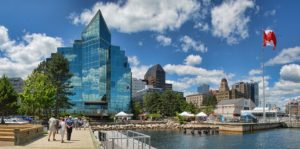Tutoring Programs
Private, In-Home Tutoring in Halifax, Nova Scotia
-
Certified Educators
-
Personalized Learning
-
1-on-1 Instruction
-
Flexible Scheduling
-
Bi-weekly Progress Reports
Halifax, Nova Scotia Tutoring Programs
Get started with SchoolTutoring Academy's tutoring programs for Halifax, Nova Scotia students.
Halifax District and Curriculum
 In Halifax, the local public schools follow the curriculum that was developed by the Nova Scotia Department of Education. The curriculum is organized into Learning Outcome Frameworks that specify what children should know and be able to do at each grade level in each subject. The expectations call for a high degree of critical thinking development. This allows teachers the flexibility to design lessons that are appropriate for their students while also ensuring that all students in the province receive the highest standards of learning.
In Halifax, the local public schools follow the curriculum that was developed by the Nova Scotia Department of Education. The curriculum is organized into Learning Outcome Frameworks that specify what children should know and be able to do at each grade level in each subject. The expectations call for a high degree of critical thinking development. This allows teachers the flexibility to design lessons that are appropriate for their students while also ensuring that all students in the province receive the highest standards of learning.
We currently cover the following Halifax-area school districts: Halifax Regional School Board, Sacred Heart School of Halifax.
Schools in Halifax include:
 LeMarchant-St. Thomas Elementary School is located at 1589 Walnut St, Halifax, NS, B3H 3S1. LeMarchant-St. Thomas Elementary School covers kindergarten through sixth grade. Contact LeMarchant-St. Thomas Elementary School at (902) 421-6769. LeMarchant-St. Thomas Elementary School is a learning community that is both diverse and unprecedented. They challenge and support all of their students as they are pushed to achieve the highest level of academic success, growth, and citizenship possible. LeMarchant-St. Thomas Elementary School is one of 84 schools in the board, and one of 20 that offer early french immersion. Located in a quiet residential area of Halifax, on a tree-lined street, they had 430 students in the 2016-17 school year. They offer programs in both french and english, as well as teachers who specialize in physical education, art, and music, as well as a dedicated library and library technician. They are in the process of constructing a new building, a new, state of the art facility where the original building was located previously. Like other schools in the province, LeMarchant-St. Thomas Elementary School teaches based on the Nova Scotia curriculum. This means that, for example, third graders in math will be exploring number sense, patterns, 3D and 2D shapes, analyze data, and use probabilities to solve problems. A specific concept taught would be counting by 1s, 2s, 5s, 10s, or 100s, starting at any point, to 1000.
LeMarchant-St. Thomas Elementary School is located at 1589 Walnut St, Halifax, NS, B3H 3S1. LeMarchant-St. Thomas Elementary School covers kindergarten through sixth grade. Contact LeMarchant-St. Thomas Elementary School at (902) 421-6769. LeMarchant-St. Thomas Elementary School is a learning community that is both diverse and unprecedented. They challenge and support all of their students as they are pushed to achieve the highest level of academic success, growth, and citizenship possible. LeMarchant-St. Thomas Elementary School is one of 84 schools in the board, and one of 20 that offer early french immersion. Located in a quiet residential area of Halifax, on a tree-lined street, they had 430 students in the 2016-17 school year. They offer programs in both french and english, as well as teachers who specialize in physical education, art, and music, as well as a dedicated library and library technician. They are in the process of constructing a new building, a new, state of the art facility where the original building was located previously. Like other schools in the province, LeMarchant-St. Thomas Elementary School teaches based on the Nova Scotia curriculum. This means that, for example, third graders in math will be exploring number sense, patterns, 3D and 2D shapes, analyze data, and use probabilities to solve problems. A specific concept taught would be counting by 1s, 2s, 5s, 10s, or 100s, starting at any point, to 1000.
 Halifax Grammar School is located at 945 Tower Road, Halifax, NS B3H 2Y2. Halifax Grammar School covers junior primary through twelfth grade. Contact Halifax Grammar School at (902) 423-9312. The Halifax Grammar School was established in 1958, and is now the leading independent day school in Atlantic Canada. They believe that all students should have the opportunity to discover their passions and to develop their capacity as people. Each day, students become more and more prepared for university, and for life beyond, by developing qualities such as independence and confidence through a curriculum that is balanced in athletics, altruism, academics, and the arts. This is because, when students truly find their purpose and reason to be, they will make the world a better place. Halifax Grammar currently has a population of 530 students. Their mission is to aid students in finding their passions, develop their potential, and serve the community. Their motto is “Inito ad Discendum / Exito ad Serviendum”, which is latin for Enter to Learn, Go forth to Serve. Just as other schools in Nova Scotia, Halifax Grammar derives its curriculum from the provincial guidelines. This means that, for example, in grade 5 language arts, students will learn to speak and listen to explore, clarify, extend, and reflect on their thoughts and ideas, communicate information and ideas succinctly, and respond to prompts personally and critically, as well as explore a range of texts, both at and slightly above their grade level in order to challenge them. One specific learning outcome detailed in the curriculum is for students to demonstrate an awareness of the needs, rights, and feelings of others by listening attentively and speaking in a manner appropriate to the situation.
Halifax Grammar School is located at 945 Tower Road, Halifax, NS B3H 2Y2. Halifax Grammar School covers junior primary through twelfth grade. Contact Halifax Grammar School at (902) 423-9312. The Halifax Grammar School was established in 1958, and is now the leading independent day school in Atlantic Canada. They believe that all students should have the opportunity to discover their passions and to develop their capacity as people. Each day, students become more and more prepared for university, and for life beyond, by developing qualities such as independence and confidence through a curriculum that is balanced in athletics, altruism, academics, and the arts. This is because, when students truly find their purpose and reason to be, they will make the world a better place. Halifax Grammar currently has a population of 530 students. Their mission is to aid students in finding their passions, develop their potential, and serve the community. Their motto is “Inito ad Discendum / Exito ad Serviendum”, which is latin for Enter to Learn, Go forth to Serve. Just as other schools in Nova Scotia, Halifax Grammar derives its curriculum from the provincial guidelines. This means that, for example, in grade 5 language arts, students will learn to speak and listen to explore, clarify, extend, and reflect on their thoughts and ideas, communicate information and ideas succinctly, and respond to prompts personally and critically, as well as explore a range of texts, both at and slightly above their grade level in order to challenge them. One specific learning outcome detailed in the curriculum is for students to demonstrate an awareness of the needs, rights, and feelings of others by listening attentively and speaking in a manner appropriate to the situation.
 Citadel High School is located at 1855 Trollope St, Halifax, NS, B3H 0A4. Citadel High School covers ninth grade through twelfth grade. Contact Citadel High School at (902) 491-4444. Citadel High was designed by the winner of an architectural design competition in order to replace two old high schools. The new school, nearly three football fields long, is 200,000 square feet of students looking for the best education possible. It was built at the foot of the historic Citadel Hill, it has many unique features, such as a curved facade, and transparent walls to save on lighting in the academic, arts, and athletic wings, as well as state of the art water and energy saving features. The three storey building also contains an additional community gymnasium and theatre. Some one of a kind green features of the school include redirecting waste to recycling facilities, recycled building components, roof collection for grey water, waterless urinals, no irrigation, heat reflecting/grass roof sections, energy conservation, low emitting materials, no fossil fuels, and unique ventilation.
Citadel High School is located at 1855 Trollope St, Halifax, NS, B3H 0A4. Citadel High School covers ninth grade through twelfth grade. Contact Citadel High School at (902) 491-4444. Citadel High was designed by the winner of an architectural design competition in order to replace two old high schools. The new school, nearly three football fields long, is 200,000 square feet of students looking for the best education possible. It was built at the foot of the historic Citadel Hill, it has many unique features, such as a curved facade, and transparent walls to save on lighting in the academic, arts, and athletic wings, as well as state of the art water and energy saving features. The three storey building also contains an additional community gymnasium and theatre. Some one of a kind green features of the school include redirecting waste to recycling facilities, recycled building components, roof collection for grey water, waterless urinals, no irrigation, heat reflecting/grass roof sections, energy conservation, low emitting materials, no fossil fuels, and unique ventilation.
Educating Our Parents: Understanding the Halifax District Curriculum
The Learning Outcomes Framework continuously undergoes revisions so that they reflect the best practices in preparing students for 21st century academic and career pursuits. One goal of the curriculum revision process is to determine what changes are occurring in society that the curriculum needs to address with students. As the world becomes more globalized and technologically advanced, subjects like technology and language immersion reflect the expectations students will meet in the world.
The subject of technology has advanced in many ways from teaching students how to use word processing, spreadsheet, and database software to introducing students to coding and programming, and allowing them to innovate new programs. There is also the integrated approach offered by STEM courses that teaches key concepts in science, technology, engineering, and math and expects students to learn how to address engineering or technological challenges. These classes also help develop a students ability to collaborate and recognize their strengths within a group setting.
Our Halifax, Nova Scotia tutoring programs are personalized just for you
Our instructors hail from Harvard, Stanford, Duke and other top institutions
Nova Scotia Tutors
See additional Nova Scotia tutors.
Keeping Informed: Recent Halifax Educational News
- Adopt-A-School - Local area businesses and community partnerships are teaming up with the schools in an innovative Adopt-A-School program. These partnerships have provided tremendous benefits to local schools – everything from new books to professionals serving as mentors or volunteers in the classroom. Of course, the benefits work both ways – the professional volunteers have the chance to step outside of their work life and make a positive impact on local children.
- Breaking Barriers - At the First Lego League (FLL) Robotic Programming Competition, a local area all-girl team captured the championship prize and qualified to compete in the North American FLL Championship in San Diego, California. Who said robots were just for boys?
- Halifax All-City Music Program - Local students who are musically talented have the option to participate in the Halifax All-City Music Program as early as their elementary school years. Students receive a wide range of music education opportunities and many opportunities to perform solo or in an ensemble.
Halifax Tutors Can Help Your Student Succeed
SchoolTutoring Academy works with young learners and students, all the way up through high school. We offer Pre-K and Kindergarten Tutoring as well as Elementary School Tutoring to build a strong learning foundation early on. We also offer comprehensive tutoring across all school subjects.
About Halifax, Nova Scotia
 Halifax is a city in the Canadian province of Nova Scotia. It is located on the Halifax Harbour, in Atlantic Canada, and it is the largest municipality and Capital of Nova Scotia. Halifax is very large, covering an area of 5500km2, and housing a population of 403,131. Halifax is a major economic centre of Eastern Canada, with a large concentration of both governmental and private sector businesses and services located there. Major employers include the Department of National Defence, Dalhousie University, and the Port of Halifax. Agriculture, mining, forestry, fishing, and natural gas extraction are all major industries found in the more rural areas of Halifax.
Halifax is a city in the Canadian province of Nova Scotia. It is located on the Halifax Harbour, in Atlantic Canada, and it is the largest municipality and Capital of Nova Scotia. Halifax is very large, covering an area of 5500km2, and housing a population of 403,131. Halifax is a major economic centre of Eastern Canada, with a large concentration of both governmental and private sector businesses and services located there. Major employers include the Department of National Defence, Dalhousie University, and the Port of Halifax. Agriculture, mining, forestry, fishing, and natural gas extraction are all major industries found in the more rural areas of Halifax.
In the 2016 Census of Population conducted by Statistics Canada, the Halifax Regional Municipality recorded a population of 403,131 living in 173,324 of its 187,338 total private dwellings, a change of 3.3% from its 2011 population of 390,086. With a land area of 5,490.35 km2 (2,119.84 sq mi), it had a population density of 73.4/km2 (190.2/sq mi) in 2016. In 2016, 15% of the population was 14 years old or younger, while 16% were 65 and older.
 Halifax Citadel
Halifax Citadel
Between 1749 and the last 19th century, Halifax was one of the four main naval stations that belonged to the British Empire overseas. The mighty Halifax Citadel was a command post and protected against land based attacks. Today, the Citadel is a tourist attraction, and they put on shows such as the firing of the noon gun, infantry manoeuvres, and soldiers dressed in traditional 19th century uniforms. For more information, please visit their website here.
 Halifax Public Gardens
Halifax Public Gardens
The Halifax Public Gardens were transformed into their current oasis by joining two adjacent gardens, a swampty wasteland and a lovely garden form an estate. The main force was the passion for horticulture of a number of locals, several of which were influential politicians with enough reach to realise their vision. The project began with the formation of the Nova Scotia Horticultural Society in 1836. They sought to have a garden supported by public donations and grants, and they were given a piece of land, rent free in 1841. Between then and 1911, the park was expanded quite a bit, with tons of new attractions and life added. Not a lot was added between 1911 and 2003, when the park was restored after a hurricane. Nowadays, most of the pieces in the park are original, and over 100 years old. For more information, please visit their website here.
 Halifax Waterfront
Halifax Waterfront
The historic port city of Halifax really comes to life as you walk along the waterfront. Starting at the historic pier 21, and walking along, you can explore eclectic shops and galleries, restaurants, and ships, including the last WWII convoy escort corvettes. You can also visit the Halifax Seaport Farmers’ Market, and the seafaring history through exhibits in the maritime museum. For more information, please visit their website here.
Interesting Facts
- Halifax is the largest population centre east of Quebec City.
- The Halifax Explosion in 1917 was the world’s largest man-made explosion prior to Hiroshima. About 2,000 people were killed and 9,000 injured when the SS Mont Blanc, a French cargo ship loaded with wartime explosives collided with an empty Norwegian ship. It caught fire and 25 minutes later exploded. A tsunami and pressure wave also occurred and caused considerable damage.
- The Old Town Clock, a famous landmark, has been keeping time since 1803.
- Halifax is closer to Dublin, Ireland than it is to Victoria, British Columbia.
- Halifax boasts the second largest ice free natural harbour in the world after Sydney, Australia.
- There are more pubs per capita than any other city in Canada.
- Halifax has a strong connection to the Titanic sinking. There is a permanent Titanic Museum at the Maritime Museum of the Atlantic.
Chalk Talk: Value of Social Media in the Classroom
 Social media has become an integral part of our daily lives. Many teachers have taken note of the power of social media as a learning platform and have begun to incorporate it into their classroom learning activities. Twitter seems to be a favorite of educators, who can use it to create a hashtag for a class project to facilitate discussion amongst classmates. Twitter can also be used to pose questions to content experts. For example, science students can tweet a question or a comment to a famous scientist in order to engage them in a conversation they would otherwise be unable to have. Another popular social media platform, Instagram, is a great way for kids in arts classes to share their work with one another. Again, teachers can create a hashtag under which students post their work, like the work of others, and comment on others’ work.
Social media has become an integral part of our daily lives. Many teachers have taken note of the power of social media as a learning platform and have begun to incorporate it into their classroom learning activities. Twitter seems to be a favorite of educators, who can use it to create a hashtag for a class project to facilitate discussion amongst classmates. Twitter can also be used to pose questions to content experts. For example, science students can tweet a question or a comment to a famous scientist in order to engage them in a conversation they would otherwise be unable to have. Another popular social media platform, Instagram, is a great way for kids in arts classes to share their work with one another. Again, teachers can create a hashtag under which students post their work, like the work of others, and comment on others’ work.




